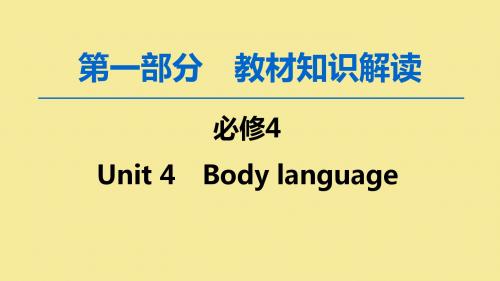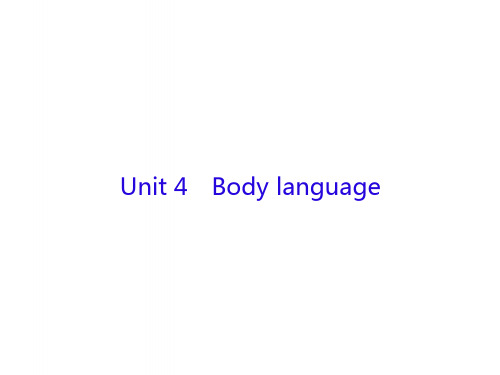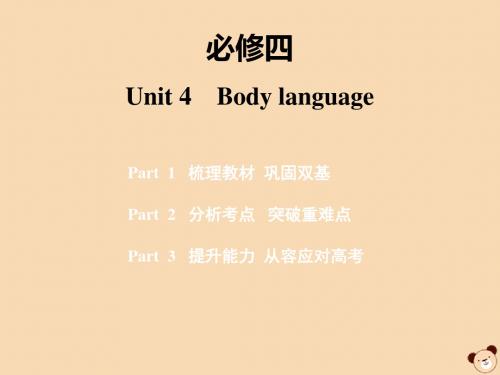(新人教版)2020届高三一轮复习Unit4Bodylanguage课件必修4(英语)
2020版高考英语一轮复习第1部分Unit4Bodylanguage课件新人教版必修4

4.The doctor will give you some medicine _to__e_a_s_e__ (ease) your pain. 5.As _a_d_u_l_ts_ (adult) ,we should be responsible for our own decisions. 6.Li Hua,my best friend,is in Shandong University _m__a_jo_r_in_g__ (major) in English literature.
答案
拓展单词 1.state v.陈述;说明→_s_t_a_te_m_e_n_t__n.陈述;说明 2.greet vi.& vt.迎接;问候→_g_re_e_t_in_g_n.问候;招呼 3.associate vt.把……联系起来→_a_ss_o_c_i_at_i_o_n_n.社团;联系;联想 4.curious adj.好奇的→_cu_r_i_o_u_sl_y_adv.好奇地→_c_u_r_io_s_i_ty__n.好奇; 好奇心 5.defend vt.保护;保卫→_d_e_f_e_n_c_e_n.防御;保卫
答案
拓展联想 1.“以-le结尾的形容词去e加y变为副词”集锦 ①horrible→horribly ②possible→possibly ③comfortable→comfortably ④gentle→gently ⑤simple→simply
第一部分 教材知识解读
必修4 Unit 4 Body language
01
栏 目
ቤተ መጻሕፍቲ ባይዱ02
导 航 03
固考基·知识梳理 析考点·重难探究 提考能·素养达标
固考基 知识 梳 理
2020届高考英语(人教版)一轮复习必修4 Unit 4 Body language课件(27张)

人教版高中英语一轮复习课件
5.我想我们还没互相介绍过,我还不知道你的名字。 I don't think we _h_a_v_e__b_e_en__in_t_r_o_d_u_c_ed__to_ each other, therefore I don't know your name. 6.他不敢那样做是因为他害怕丢脸。 He dare not do that because he is afraid of__l_o_s_in_g__fa_c_e_. 7.总的来说,她的作品不错,不过这篇文章糟透了。 _I_n__g_en_e_r_a_l_her work has been good, but this essay is dreadful.
They _d_e_fe_n_d_e_d__th_e_i_r_c_o_u_n_tr_y_a_g_a_i_n_s_t/_fr_o_m_ enemies. (2)许多英雄儿女为捍卫自由而牺牲。 Many heroic men and women have died __i_n_d_e_f_e_n_c_e_o_f_liberty.
人教版高中英语一轮复习课件
4.likely adj.可能的;预期的 例句 It isn't likely to rain.不太像要下雨。 搭配 It is likely that-clause 很可能……/有希望……
sb./sth.be likely to do sth.某人/物很可能/有希望做某事 辨析 possible/likely/probable 这三个词都可表示“可能的”,实现的可能性依次递增。 possible 常用于“It is possible for sb.to do sth.” 或“It is possible that-clause”;而 probable 只用于“It is pro-bable that-clause”; 三者中只有 likely 可以用人作主语。 运用 用上面所提供的辨析词填空 (1)We will come as soon as__p_o_s_si_b_le_. (2)She is very _l_ik_e_l_yto enter a key university. (3)It is _p_ro_b_a_b_l_e_ that the disease has a genetic element.
高三英语一轮复习Unit4Bodylanguage课件新人教版必修4

2. 高频单词·应用 ①________ adj. 可能的 ②________ vt.& vi. 接近;靠近 n. 接近;方法;途径 ③________ vt. 代表;象征 ④________ vt. 保护;保卫 ⑤________ vt. 减轻(痛苦、忧虑) ⑥________ vi. 起作用;运转 ⑦________ vt. 误解;误会 ⑧________ vt.& vi. 迎接;问候 n. 安逸;舒适
⑪打哈欠
⑫皱眉 ⑬等级; 军衔 ⑭食堂 ④ defend ⑧greet
③represent
⑦ misunderstand ②statement; state true; truth ⑦employee; ⑧facial; face simplify
3. ①curious; curiously; curiosity ⑥respectful; respect unemployment ⑩simply; simple;
⑪opposed 反对的 ⑬favorable 赞同的
⑫ approving 支持的;同意的 ⑭critical 批评的
3. -ly 构成的形容词集锦 ①likely 可能的 ③friendly 友好的 ⑤weekly 每周的 ⑦orderly 整洁的 ⑨lonely 孤独的 ②lovely 可爱的 ④lively 活泼的 ⑥costly 昂贵的
⑤hug n.& vt. ⑦subjective adj. ⑨false adj. ⑪yawn vi. ⑬rank n.
⑥dash n. & vi. ⑧crossroads n. ⑩adult n.
________ ________ _________ ⑭canteen n. ________
2020高考英语一轮复习Unit4Bodylanguage课件新人教版必修4

高考运用:语法填空
①His greatest dream is
(represent) his country to take
part in the Olympics.
②The competition attracted over 500 players
(represent)
eight different countries.
不尽相同,身体接触和相互间距离的程度也并不一样。
考点知识·导练
1.represent vt.代表;描绘;表现;体现;象征;相当于
解疑难·提知能
①represent...as...把……描绘成…… ②represent oneself as/to be...自称是…… ③represent sth. to sb.向某人说明某事
从哥伦比亚来的托尼· 加西亚,随后紧跟着的是英国的朱莉娅·史
密斯。
2. Not
all
cultures . greet each other the same way,
nor are they comfortable in the same way with touching
or distance between people.各种文化背景下人们互致问候的方式
vt.误解;误会
8. function n.作用;功能
functional 9. anger
angry
angrily
adj.实用的 n.怒气;怒火 adj.生气的 adv.生气地
10. truly true
truth 11. subjective
subject 12. approach
13. dash 14. ease 15.major 16.rank
高考英语一轮复习Unit4Bodylanguage课件新人教版必修

7. in general
总的来说;通常
8. lose face
丢脸
9. as if
好像
10. put up
举起;张贴;搭建;留宿
Ⅱ重点短语拓展用活
1.in general 总的来说;通常
(1)as a general rule 背
generally speaking 相
(2)on the whole=to sum up 关
背 satisfy the needs of young lovers. 随着七夕节的临近,许多商店出售商品以满足年轻情侣的需求。
写 ②At the approach of the rain and the wind, the swallows are busy.
作 在风雨来临之际,燕子们很是繁忙。
句 她把她的妈妈描绘成世界上最好的母亲。
2.curious adj.好奇的
背 (1)be curious about
词 be curious to do sth.
条 (2)with curiosity
用 out of curiosity
法
对……感到好奇 渴望做某事 好奇地 出于好奇
背 ①Chinese students are curious about the school life of American 写 students. 作 中国的学生对美国学生的学校生活非常好奇。
背 nice person in general. 彼得有时可能确实难以相处,尽管总体来讲他是一个好人。
写 ②Generally speaking, the number of the people who drive after
作 drinking is smaller and smaller.
高考英语一轮复习 Unit-4 Body language课件 新人教版必修4

prevent conflicts and end wars.
(2)For example, Australia, _a_m__a_j_o_r_w_h__ea_t__e_x_p_o_r_te_r__ (一
这幅画描绘暴风雨。
用法归纳
represent vt.
代表;象征
represent vt.
表现;描写;描画
represent vt.
声称
对应训练 (1)We chose a mittee to______r_e_p_r_es_e_n_t(u代s 表我们).
(2)He__re_p_r_e_s_e_n_t_ed__ (声称)himself as a philosopher.
Tell them that their father died in defence of their future.
告诉他们,父亲是为了保护他们的未来而死的。
用法归纳
defend vt.
保护;保卫
defend againse n.
防御;保卫
in defence
保卫;保护
kissed her on the cheek! (Page 26)
The day of the meeting approached.
开会的日子临近了。
用法归纳
approach vt.& vi.
接近;靠近;走进
approach n.
接近;方法;途径
approach vt.
着手处理;与……打交道
approach n.
mother.(英译汉)
孩__子__们__冲__进__卧__室__,__向__母__亲__问__好__。_
(4)她Sh以e g笑re容et迎ed接m我e w。it(h汉a译sm英il)e. _________________________
2020版高考英语一轮复习Unit4Bodylanguage课件新人教版必修4

Ⅱ.词汇积累
1.“主要的;首要的”的形容词一览
①major
主要的;重要的
②main
主要的
③primary
主要的;首要的
④principal
主要的;首要的
⑤chief首要的返回导航2.常见“人体部位及器官”名词荟萃
①cheek
脸颊
②forehead
额头
③chest
胸部
④shoulder
肩膀
⑤throat
喉咙
⑥tongue
舌头
⑦lung
肺
⑧liver
肝脏
返回导航
3.“方法”种种 (1)做某事的方法 ①the approach to doing sth. ②the way to do/of doing sth. ③the means of doing sth. ④the method of doing sth. (2)用这种方法 ①in this way ②by this means ③with this method
必修四
Unit 4 Body language
Part 1 梳理教材 巩固双基 Part 2 分析考点 突破重难点 Part 3 提升能力 从容应对高考
Part 1 梳理教材 巩固双基
返回导航
返回导航
Ⅰ.单词拼写 1.__m_a_j_o_r__ adj. 2.__c_h_e_e_k__ n. 3.__a_p_p_ro__ac_h__ vt.& vi.
6.In time of war,lots of money will be spent on __d_e_f_e_n_c_e_ and many measures will be taken to __d_e_f_e_n_d__ a country from being
2020版高考英语一轮复习Book4Unit4Bodylanguage课件新人教版

◆单句改错 ⑤Suddenly the girl quieted down round.
curious→curiously ◆完成句子 ⑥出于好奇,其他所有的学生都很想知道老师为什么表扬我。 Out of curiosity, all the other students were curious to know why the teacher praised me .
点拨 (1)be curious about对……感到好奇 be curious to do sth.很好奇地做某事;很想做某事 (2)out of curiosity出于好奇 meet/satisfy one's curiosity满足某人的好奇心 with curiosity=curiously好奇地
点拨 (1)represent...as...把……描绘成…… represent sb. to do sth.代表某人做某事 represent sth. to sb.向某人提出某事 (2)representative n.代表 adj.典型的;有代表性的 a representative of...……的代表
◆单句填空 ②She represents her mother as the kindest mother in the world. ③Much to his delight, the top student will represent his school to make (make) a speech at the meeting. ④In the afternoon, he together with some of our student representatives (representative)is going to visit the Haihe River and enjoy the beautiful scenery there.
高考英语一轮复习 Unit4《Body language》超级课件 新人教必修4

• 6. adult n.成人,成年人 adj.成人的,成熟的 • 7. spoken adj.口语的→ unspoken adj.未说出口的 • 8. facial adj.面部的 • 9. function n.作用,功能 vi.起作用,运转 • 10. false adj.错误的,假的 • 11. anger n.怒气,怒火→angry adj.愤怒的
Байду номын сангаас
• However,if I had to give up one of them,I would turn off the TV rather than switch off my cell or cut off the Internet.I could do without TV because few shows take my fancy and there're too many commercials.Besides,most programs on TV are also available elsewhere.
• 12. subjective adj.主观的→ subject n.主语,主题
• 13. rank n.等级,军衔 • 14.represent vt.代表;象征→ representation.表现;表
示;代理→ representative adj.有代表性的,典型的
• 15.curious adj.好奇的→ curiosity n.好奇,好奇心
defend用法,根据句意,此处defend意为: 为……做辩护,为及物动词。
• [正确答案] C
• Ⅰ.重点单词 • 1. statement n.陈述;声明→state vt.陈述;声明 • → statesman n.发言人 • 2.greet vt. & vi.迎接;问候→greeting n.招呼;问候 • 3. major adj.主要的→ majority n.多数,大多数 • 4. misunderstand vt.误解,误会→ misunderstandingn. • 误解 • 5.dash vi.猛冲,突进→ dashing adj.振奋的
高考英语一轮总复习Unit4BodyLanguage课件新人教版选择性必修第一册

UNIT4 BODY LANGUAGE研考点 核心突破目录索引强基础 语基自测12测效果 课堂评价3研真题 链接高考4强基础 语基自测默写查验一、核心单词1. adj .合适的;恰当的 2. vt .当场看到;目击;见证 n .目击者;证人 3. n .面颊;脸颊4. vi .鞠躬;点头 vt .低(头) n .弓;蝴蝶结5. n .隔阂;障碍6. n .故作姿态;(为画像、拍照等摆的)姿势 vi .摆好姿势 vt .造成(威胁、问题等)7. vt .& vi .( , )(使)弯曲;倾斜;偏向appropriate witnesscheek bowbarrierpose bend bent bent8. vt .使更清晰易懂;阐明;澄清9. vt .把……放低;降低;减少 adj .下面的;下方的;较小的10. vt .意味着;暗示 11. vi .盯着看;凝视 n .凝视 12. vt .察觉;看待;理解13. vi .& vt .费心;麻烦;因……操心 n .麻烦;不便14. vi .& vt .哭泣;流泪15. n .矛盾;冲突 vi .冲突;抵触clarify lower implystareperceive bother weep conflict二、派生单词1. n .交流;相互影响→ vi .相互交流;相互影响2. vi .(根据情况)变化;改变→ adj .不同的;各种各样的→ n .多样性;变化;种类3. vi .赞成;同意 vt .批准;通过→ n .赞成;同意;批准→ adj .赞许的;赞成的→ vi.不同意 4. vt .使用;应用;雇用→ n .雇员;受雇者→ n .雇主;雇用者→ n .雇用;聘用interaction interact varyvarious variety approve approval approving disapprove employ employee employer employment5. vt .较喜欢;选择;有利于 n .帮助;恩惠;赞同→ adj .赞成的;有利的 6. n .愤怒;怒气 vt .使生气;激怒→ adj .生气的;愤怒的→ adv .生气地;愤怒地 7. n .教师;教育工作者;教育家→ vt .教育→ adj .受过教育的;有教养的→ n .教育8. n .趋势;倾向→ vt .& vi .照料;护理 vi .倾向于;有……的趋势9. vt .占据;占用→ adj .使用中;忙于;被占领的→ n .占领;职业10. vt .分散(注意力);使分心→ n .分心;分散favour favourable anger angryangrilyeducator educate educated education tendency tend occupy occupied occupation distract distraction11. vi .& vt .区分;辨别→ adj .卓越的;杰出的 12. n .焦虑;担心;害怕→ adj .忧虑的;焦虑的;渴望的→ adv .焦虑地13. adj .难堪的;尴尬的→ adj .使人难堪的;令人尴尬的→ vt .使窘迫;使尴尬→ n .难堪;窘迫 14. adj .羞愧;惭愧→ n .羞耻;羞愧;让人遗憾的事→ adj .可耻的→ adj .无耻的;没廉耻的 15. vi .& vt .询问;打听→ n .询问;调查16. vt .调整;调节 vi .& vt .适应;(使)习惯→ adj .可调整的;可调节的→ n .调整;调节;适应distinguish distinguished anxiety anxiousanxiously embarrassed embarrassing embarrass embarrassmentashamed shameshameful shameless inquire/enquire inquiry/enquiry adjust adjustable adjustment三、重点短语1. 相比之下2. (与……)相比较3. 消除;分解;打破4. 直起来;整理;收拾整齐5. 换句话说;也就是说6. (短暂地)访问;要求(某人讲话等);正式邀请7. 有某种影响;在工作by contrast by comparison break downstraighten upin other wordscall on at work8. 陷入冲突 9. 适应 10. 对……作出反应get into conflictadjust toreact to四、典型句式1.“否定词+比较级”表示最高级教材原句:And if we are feeling down or lonely,there is nothing better than seeing the smiling face of a good friend.2.部分否定教材原句:Of course,not everyone who looks up is paying attention in class.3.while引导让步状语从句教材原句:While it is easy to perceive when students are interested,bored,or distracted,it is sometimes much harder to distinguish when students are troubled.4.have sth done结构教材原句:Students who are angry,afraid,or experiencing anxiety may have their arms crossed in front of their chests and their legs closed or crossed,like they are guarding their bodies.Ⅰ.用所给单词的适当形式填空1.The library (witness) a really enjoyable time at school.2.He made a silly mistake,so he (lower) his head,not daring tolook up.3. (clarify) his opinion of the incident,Mr Smith sat down and listened to others '.4.I 'm sorry (bother) you,but could you tell me the way to the station?语境应用witnessed lowered Having clarified to bother5.She (weep) sadly,wiping her tears with a tissue.6.Her voice trembled with excitement and tears rolled down her (cheek). nguage researchers say pronunciation and fluency are the biggest _______ (barrier),followed by grammar in effective spoken English. 8.The delegates present at the meeting (pose) for a group photograph.wept cheeks barriersposedⅡ.用所给词的适当形式填空1. of after-class activities will be held, from the English Corner to the Literature Club.So we students can get ____________ experiences.(vary)2.I feel of my action,which is a ________ to me.(shame)3.Much to my ,he asked me an question.I felt so ____________that my face was red.(embarrass)Varieties varying various ashamed shameful shame embarrassment embarrassing embarrassed4.As often say,the can likely hunt for a better job and teenagers should receive further for their future.(educate) 5.What me was that my son was late for school this morning and I warned him not to do that again.(anger) 6.I am with my ,which most of my time every day.(occupy)7.In her thirties,she herself as an ter,she became a coach.(distinguish) educators educated education angeredangrilyoccupied occupation occupies distinguished distinguished8.The government is aiming at full and calls on local ________to more .(employ)9.The seat of the car is ,so you can it according to your height.But your should be appropriate to ensure safety.(adjust)10.His has a great effect on his health.So his parents are for him.They wait for a psychologist to help his son.(anxiety) employment employers employ employees adjustable adjustadjustment anxiety anxious anxiously11.His parents didn 't of his marriage.So he tried his best toget his parents ' .However,they still .(approve)12.There is a growing for people to return to the hometown to start their business.The middle-aged to do that.(tend) approve approval disapproved tendency tendⅢ.用左栏所给短语的正确形式填空1. ,solar energy is cheap and friendly to the environment.2.Helen was her bedroom when she heard her mother crying for help in the kitchen.3.It was the bright smile on her face that my feeling ofembarrassment,so we began talking happily.4.The activity is aimed to students to take exercise for an hour every day.By contraststraightening up broke down call onⅣ.微写作1.直到那时我才突然意识到没有人比我更幸福了。
高考英语一轮复习课件19:Unit 4 《Body language》(新人教版必修4)

范例:
I Want to Smile There are many advantages of smiling.It can not only make us happy, but also please others.If we smile at life, life will smile on us in return.So I want to smile at all whenever and wherever possible. First, I would like to smile at my parents because they have given me life and take all the trouble to bring me up.They arrange almost everything for me.With their help, I have made great progress.I would like to say “Thank you” to them with a smile.Then my smile should go to myself, for only in this way can I gain more confidence in smiling my troubles away and live a better life. In a word, let's greet every day with a smile.Tomorrow is another day.
The most universal 6.__f_a_c_ia_l__ expressions is, of course, the smile—its function is to show happiness and put people 7.__a_t_e_a_s_e_.It does not always mean that we are truly happy, however.Smiles around the world can be 8._f_a_l_se____, hiding
- 1、下载文档前请自行甄别文档内容的完整性,平台不提供额外的编辑、内容补充、找答案等附加服务。
- 2、"仅部分预览"的文档,不可在线预览部分如存在完整性等问题,可反馈申请退款(可完整预览的文档不适用该条件!)。
- 3、如文档侵犯您的权益,请联系客服反馈,我们会尽快为您处理(人工客服工作时间:9:00-18:30)。
n. 磁带 n. 雇员 n. 姿态;体态 n. 拳头 adj. 错误的;假的 adj. 恭敬的 adj. 主观的 adv. 简单地;只
转换词汇
1. He repeated her __s_ta_t_e_m__e_n_t_(state) word for word. 形容词物主代词修饰名词。
2. Is there any man unwilling to fight in _d_e_f_e_n_c_e__ (defend) of his country? 因in defence of(保卫)是固定搭配。
n. 十字路口 vt. 读错;误解 n. 功能 vi. 起作用;运转 n. 宿舍 n. 等级;军衔 n. 食堂 n. 飞行;航班 vi. 打呵欠
9. fist 10. cassette 11. posture 12. employee 13. subjective 14. respectful 15. false 16. simply
重点词汇讲练
1. represent vt. 代表;象征
例句 What does WTO represent? WTO代表什么?
派生 representation n. 表现;描述;表现法 representative adj.代表的 n.代表
运用
⑴ 她代表同学们出席了这次学校会议。 She _r_e_p_r_e_s_e_n_t_e_d_h__e_r _c_la_s_s_m__a_t_e_s__at the school meeting.
very close to others or touch stranger as soon as strangers
they meet. However, people from places like Spain, Italy and South American countries approach
The most universal 6 _f_a_c_ia_l_ (face) expression is, of course, the smile—its function is to show 7 __h_a_p_p_i_n_e_s_s_(happy) and put people at ease. It does not always mean that we are 8 _t_r_u_ly__(true) happy, however. Smiles around the world can be false, hiding other feelings like anger, fear or worry. There 9 __a_re__(be) unhappy smiles, such as when someone “loses face” and smiles 10 _t_o__h_id_e__(hide) it. However, the general purpose of smiling is to show good feelings.
with
language, they also express his feelings using their
unspoken “language” through physical distance, actions or posture.
English people, for example, do not usually stands stand
背弃某人
美句必背
1. … so it is an __a_m_a_z_i_n_g__(amaze) thing that we understand each other as well as we do.…… 所以我们能彼此理解,这真是件令人惊奇的事 啊!
2. Not all cultures greet each other the same way, _n_o_r__ are they comfortable _in__ the same way with touching or distance between people.各种 文化背景下人们互致问候的方式不尽相同,对 身体接触和相互间距离的接受程度也并不一样。
⑵ 我代表学校给您打电话。 _I_r_e_p_r_e_s_e_n_t_o_u__r_s_c_h_o_o_l__ to call you.
3. These actions are not good or bad, _b_u_t_ are simply ways _in__ which cultures have developed. 这些行为不能说它好,也不能说它不好,这只是文 化发展方式(不同罢了)。
4. However,people from places like Spain, Italy or South American countries approach others closely and are more likely _to__t_o_u_c_h__ (touch) them.不过,来自西班牙、意大利和南 美国家的人会站在离别人很近的地方,而且更 可能会(用身体)接触对方。
Unit 4 Body language
词句基础过关 课文经典回顾 重点词汇讲练 写作句型仿写
词句基础过关
写作词汇
1. _r_e_p_r_e_s_e_n_t_ love and success 象征爱和成功 2. _m_i_s_u_n_d_e_r_s_t_a_n_d__ my words误解了我的言语 3. _h_u_g___ his waiting wife拥抱等候着他的妻子 4. _g_r_e_e_t_ her with a kiss 亲吻她以表问候
5. Her heart was filled with _u_n__s_p_o_k_e_n_ (speak) words but she failed to utter a single one. 修饰名词用形容词, 由failed to utter a single one可知应用否定形式。
6. Each warrior has different _f_a_c_ia_l__(face) expression and manner. 修饰名词用形容词。
3. I benefited much from my _a_s_s_o_c_i_a_t_io_n_ (associate) with him. 形容词性物主代词修饰名词。
4. I must weigh my words to avoid any _m_i_s_u_n_d_e_r_s_t_a_n_d_i_n_g__(misunderstand). 因avoid后接动名词作宾语。
major/main
10. one of our _______ objectives我们的主要目 标之一
11. be __c_u_r_io_u__s_ about everything 对一切好奇
12. be _l_ik_e_l_y__ to succeed 很有可能成功
阅读词汇
1. yawn 2. misread 3. function 4. rank 5. flight 6. canteen 7. dormitory 8. crossroads
use other greetings as well, such as the Japanese, who prefer to bow.
1. others→ other 因each other是固定词组。 2. same前加the 因same习惯上总是与the连 用。 3. to→ with 因communicate with(与……交 流; 用……来交流)为固定搭配。 4. his→ their 句子的主语是they,故此处相 对应用their。 5. stands→ stand 因do not后接动词原形。
or
others closely and are more likely to touching touch
them. Most people around the world now greet each other by shaking a hands, anof a baby is _t_r_u_ly___(true) a blessed event. 修饰谓语用副词。
8. His charges were met with cries of __a_n_g_e_r__ (angry). 介词of后用名词作宾语。
9. A deer behind the tree looked at us _c_u_r_i_o_u_s_ly_ (curious). 修饰谓语用副词。
5. …, but what __if_ we don’t know who the new person is? ……,但是如果我们不知道新来的 那个人的名字怎么办?
课文经典回顾
语法填空
Body language is one of the most powerful means of communication, often even more powerful than 1 _s_p_o_k_e_n__(speak) language. People around the world show all kinds of feelings, 2 _w_i_s_h_e_s__(wish) and attitudes that they might never speak aloud. 3 _I_t _is possible to “read” others around us, even 4 __if__ they do not intend 5 __f_o_r_ us to catch their unspoken communication. Of course, body language can be misread, but many gestures and actions are universal.
